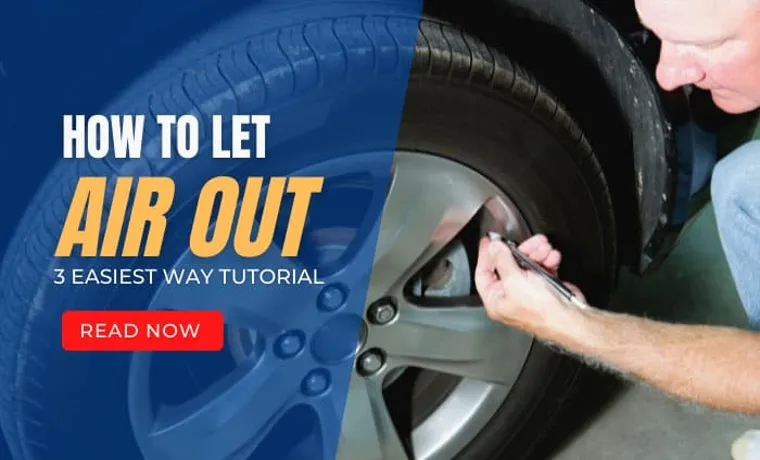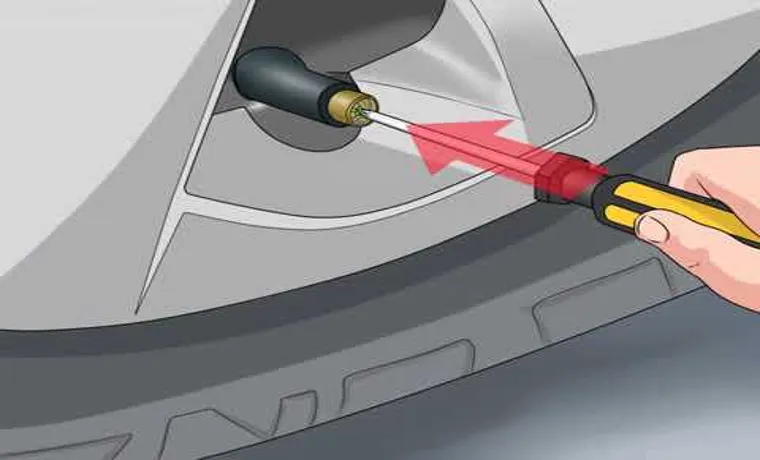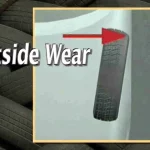Feeling a little uneasy about releasing air out of your tire? Maybe you’ve been driving for a while and notice that your tires are overinflated. Whatever the case may be, it’s essential to know how to release air out of a tire properly. If you’re not sure how to do it, fear not! This blog post will guide you through the simple steps you need to take to release air out of your tire safely.
We’ll discuss the tools you’ll need, how to check your tire pressure, and how to release air out of your tire without causing any damage. So buckle up and let’s talk about tire pressure!
Table of Contents
Gather Necessary Tools
If you’re wondering how to release air out of a tire, the first step is to gather all the necessary tools. You’ll need a tire pressure gauge and a tire valve cap removal tool. While it’s possible to release air from a tire without a gauge, it’s not recommended, as you may release too much air and damage your tire.
Tire pressure gauges are inexpensive and readily available at auto parts stores and online retailers. Be sure to choose the correct gauge for your type of tire, as there are different types of gauges for different vehicles. Once you have your gauge and valve cap removal tool, you’re ready to release air from your tire and get it back to the proper pressure for optimal performance and safety.
Check for Tire Pressure Gauge
Checking for tire pressure is an essential part of maintaining the longevity and performance of your vehicle. To get started, you’ll want to gather the necessary tools. The most important item is a tire pressure gauge, which you can find at any auto parts store or online.
Once you have your gauge, you’re ready to start checking your tire pressure. It’s important to make sure your tires are cold before you check their pressure, as hot tires can give you inaccurate readings. Find a flat surface to park on and unscrew the valve cap on one of your tires.
Press the gauge firmly onto the valve stem and wait for the gauge to give you a reading. Make sure to write down each tire’s pressure so you can compare them later. The optimal tire pressure is typically listed in your vehicle’s owner manual or on a sticker inside the driver’s side door.
It’s important to keep your tires at the correct pressure, as underinflated tires can reduce fuel efficiency and wear out more quickly, while overinflated tires can be dangerous and lead to blowouts. By checking your tire pressure regularly, you can help ensure your vehicle is performing at its best and avoid any potential safety hazards on the road.

Locate Tire Valve Stem
When it comes to fixing a flat tire, the first step is to locate the tire valve stem. This is where you will inflate the tire or release air when needed. To do this, you will need a few tools: a tire gauge, an air pump, a tire valve caps remover tool, and a flashlight (if needed).
Once you have gathered these tools, make sure your car is parked on a flat surface and the hazard lights are on. Then, visually inspect each tire to locate the valve stem. It is usually located on the outer edge of the wheel, either on the sidewall or the surface of the rim.
Once you have located the valve stem, you can proceed with checking the tire pressure or inflating the tire. Remember to always replace the valve cap after inflating or releasing air to keep dirt and debris out and maintain proper tire pressure. By mastering this first step, you’ll be well on your way to safely fixing your flat tire.
Remove Valve Cap and Press Valve Core
If you want to release air out of your tire, the first thing you need to do is remove the valve cap from the tire. This is the small plastic or metal cap that covers the valve stem. Once the valve cap is removed, you can use a valve core tool or the edge of a coin to press down on the valve core inside the valve stem.
This will release the air from the tire. It’s important to note that you should only release air when necessary and be careful not to release too much at once. If you release too much air, your tire pressure may become too low, causing uneven wear and tear on your tires or flat tires.
Always check your tire pressure with a pressure gauge before and after releasing air.
Unscrew Valve Cap
When it comes to removing a valve cap on your car tire, the process is quite simple. The first step is to unscrew the valve cap counterclockwise until you can remove it completely. Once the valve cap is removed, it’s time to move onto the valve core.
Pressing down on the valve core will release any built-up air pressure in your tire. This step is necessary before inflating your tire because it ensures accurate pressure readings and helps prevent over-inflation. Be sure to have a tire gauge handy to check the pressure as you inflate your tire to the recommended level.
It’s important to note that if you notice any damage to your valve stem or the valve core itself, it’s best to replace it immediately to avoid any potential safety hazards. By following these simple steps, you can keep your tires properly inflated and maximize their lifespan, ultimately saving you time and money in the long run.
Press Valve Core to Release Air
If you’re planning on releasing some air from your tire, the first step is to remove the valve cap. But once that’s taken care of, you still need to know how to release the air. The easiest way to do this is by pressing the valve core.
This is the small metal piece that sits at the center of the valve stem. When you depress it, it opens a pathway for air to escape. You can do this by using your finger or a valve core tool.
The latter is a small, inexpensive tool that can be easily carried in your car’s glove box. Once you’ve pressed the valve core, you’ll hear air hissing out of the tire. Depending on how long the valve is pressed, more or less air will be released.
So make sure you release the air slowly and check the tire pressure regularly to ensure it doesn’t fall too low. By following these steps, your tire pressure will be back within the recommended range in no time!
Measure Tire Pressure and Re-adjust as Needed
If you want to maintain good tire health, it’s crucial to measure your tire pressure regularly and adjust it as needed. The right tire pressure allows for better fuel efficiency, longer tread life, and better handling on the road. However, sometimes your tires can be overinflated, which can cause excessive wear in the center of the tire tread and decreased traction, or underinflated, which can cause excessive wear on the outer edges of the tire tread and decreased handling ability.
If you need to release air out of your tire, you can use a tire pressure gauge to check the pressure, and then remove the valve cap and press the gauge onto the valve stem to release the air. It’s important to only release the amount of air necessary to achieve the recommended tire pressure, which can be found in your owner’s manual or on a sticker located on the driver’s side door jamb. By regularly checking and adjusting your tire pressure, you can ensure a safer and more comfortable ride.
Check Tire Pressure
Keeping your car’s tires inflated to the manufacturer’s recommended pressure can have a major impact on your car’s overall performance, handling, and safety. Underinflated tires can cause increased fuel consumption and tire wear, reduced handling, and increase the risk of blowouts and accidents. Overinflated tires, on the other hand, can reduce traction and braking performance, affecting the car’s safety during acceleration, stopping, and cornering.
To ensure your tires are properly inflated, you can use a tire pressure gauge to check the pressure regularly. If you notice that your tires are underinflated, use a compressor to add air until they reach the recommended PSI. If they’re overinflated, release some air until they’re at the recommended level.
Remember to check your tire pressure every month or before long road trips. By checking your tire pressure regularly, you can improve your car’s performance, handling, and overall safety. So, take care of your car’s tires, and they’ll take care of you!
Refill if Necessary
When it comes to maintaining your tires, checking the pressure is crucial. Not only does it help with your car’s fuel efficiency and handling, but it also enhances your safety on the road. Therefore, it’s essential to measure the tire pressure regularly and re-adjust it if necessary.
The recommended pressure can vary depending on your vehicle’s make and model, so it’s crucial to check the owner’s manual or the label inside the driver’s door. Typically, the pressure should range between 30 and 35 PSI. You can use a tire pressure gauge to measure the pressure accurately, and if it’s below the recommended level, you need to refill the tire until it reaches the required pressure.
Keep in mind that overinflated or underinflated tires can cause uneven tread wear, reduce traction, and result in a blowout, leading to serious accidents. Therefore, make it a habit to monitor and maintain your tire pressure regularly to ensure your safety and prolong the lifespan of your tires.
Replace Valve Cap and Double Check Tire Pressure
If you need to release air out of a tire, it’s important to follow a few simple steps to ensure safety and accuracy. First, use a valve cap removal tool or a pair of pliers to remove the valve cap from the tire. This will allow you to access the valve stem, which is where the air exits the tire.
Next, press down on the valve stem to let out air slowly. Use a tire pressure gauge to check the pressure as you go, making sure to release only the amount of air necessary to reach the desired pressure. If you release too much air, you may need to add more back in using a tire pump.
Once you have reached the correct pressure, reattach the valve cap and double-check the pressure to be sure it is still within the safe range for your vehicle. Remember, maintaining proper tire pressure is important not only for safety, but also for optimal fuel efficiency and tire lifespan. By following these simple steps, you can release air out of your tires safely and accurately.
Screw Valve Cap back in Place
Once you’ve finished inflating your tire, it’s important to screw the valve cap back on to prevent any debris or dirt from getting inside the valve and causing damage. The valve cap also serves as a seal, preventing any air from leaking out of your tire. Make sure to screw the cap on tight with your fingers, but don’t use any tools as that could damage the cap or valve.
After you’ve screwed the cap back on, it’s a good idea to double check your tire pressure with a tire gauge. If the pressure is too low, add more air until it reaches the recommended PSI level for your tire. Doing so will ensure that your tire is properly inflated and that you’ll have a safe and comfortable ride.
Always remember to check your tire pressure regularly, as it can change over time due to changes in temperature or normal wear and tear. With the valve cap properly screwed in place and the tire pressure at the correct level, you can confidently hit the road knowing that your tires are in top condition. So, next time you inflate your tire, don’t forget to replace the valve cap and double check your tire pressure for optimum performance and safety.
Confirm Tire Pressure is Correct
After inflating your tires, it’s important to check the pressure to make sure it’s correct. This will not only ensure a smoother ride, but also increase fuel efficiency and extend tire life. We recommend using a tire pressure gauge to get an accurate reading.
Once you confirm the pressure is correct, don’t forget to replace the valve cap. This will prevent dirt and debris from entering the valve and causing leaks. Double checking the pressure one more time before hitting the road can give you peace of mind that your tires are ready for the journey.
Remember, proper tire pressure is key to safe and efficient driving. So, take the time to check and maintain it regularly to keep your vehicle in tip-top shape.
Conclusion
In conclusion, releasing air out of a tire is a lot like letting out a deep sigh after a long day. Just like the tension and stress in your body can be relieved by exhaling, the excess pressure in your tire can be relieved by simply pressing down on the valve stem. So, if you’re feeling weighed down by the weight of the world (or the weight of your car), take a deep breath and remember – releasing air out of a tire is as easy as breathing.
“
FAQs
What is the reason for releasing air out of a tire?
Releasing air out of a tire helps to adjust the tire pressure, which can affect the performance, fuel efficiency, and safety of the vehicle.
How can I check the tire pressure before releasing air?
You can use a tire pressure gauge to check the current pressure of the tire and compare it with the manufacturer’s recommended pressure.
Is it safe to release air from a hot tire?
No, it is not safe to release air from a hot tire, as it can cause severe damage to the tire and lead to an accident. Wait for the tire to cool down before releasing air.
What is the recommended method for releasing air from a tire?
The recommended method is to use a tire pressure gauge and a valve stem tool to release air slowly and precisely. It should be done evenly from all four tires.
Can releasing too much air damage the tire or rim?
Yes, releasing too much air can cause the tire to become deformed, lead to rim damage and can also cause the tire to rupture.
Why is it essential to maintain proper tire pressure?
Maintaining the proper tire pressure can prevent accidents, improve fuel economy, increase tire life and maintain a smooth ride.
How often should I check tire pressure to prevent the need to release air?
It is recommended to check tire pressure once a month and before any long trips. Proper maintenance can prevent the need to release air and ensure optimal tire performance.



